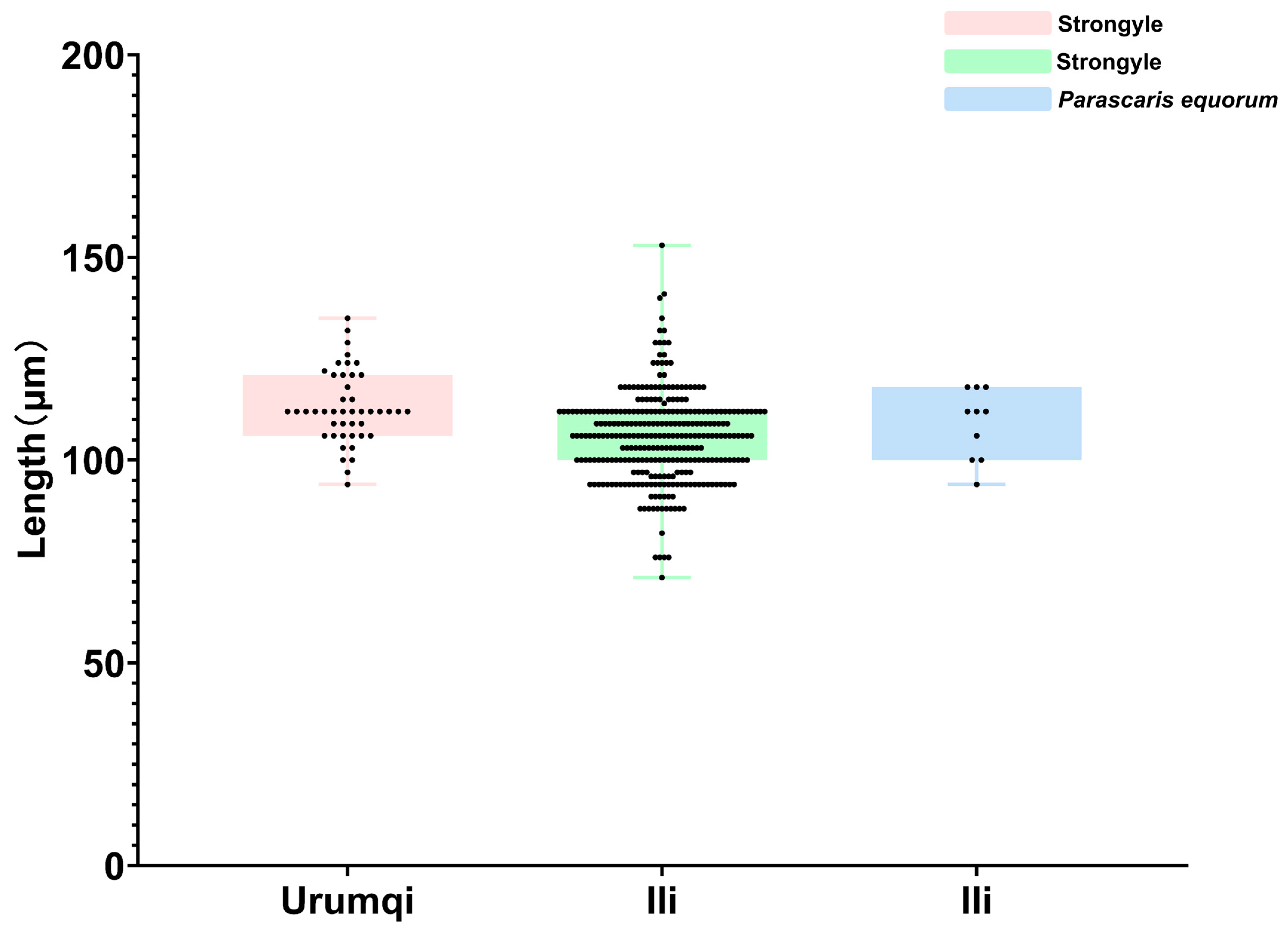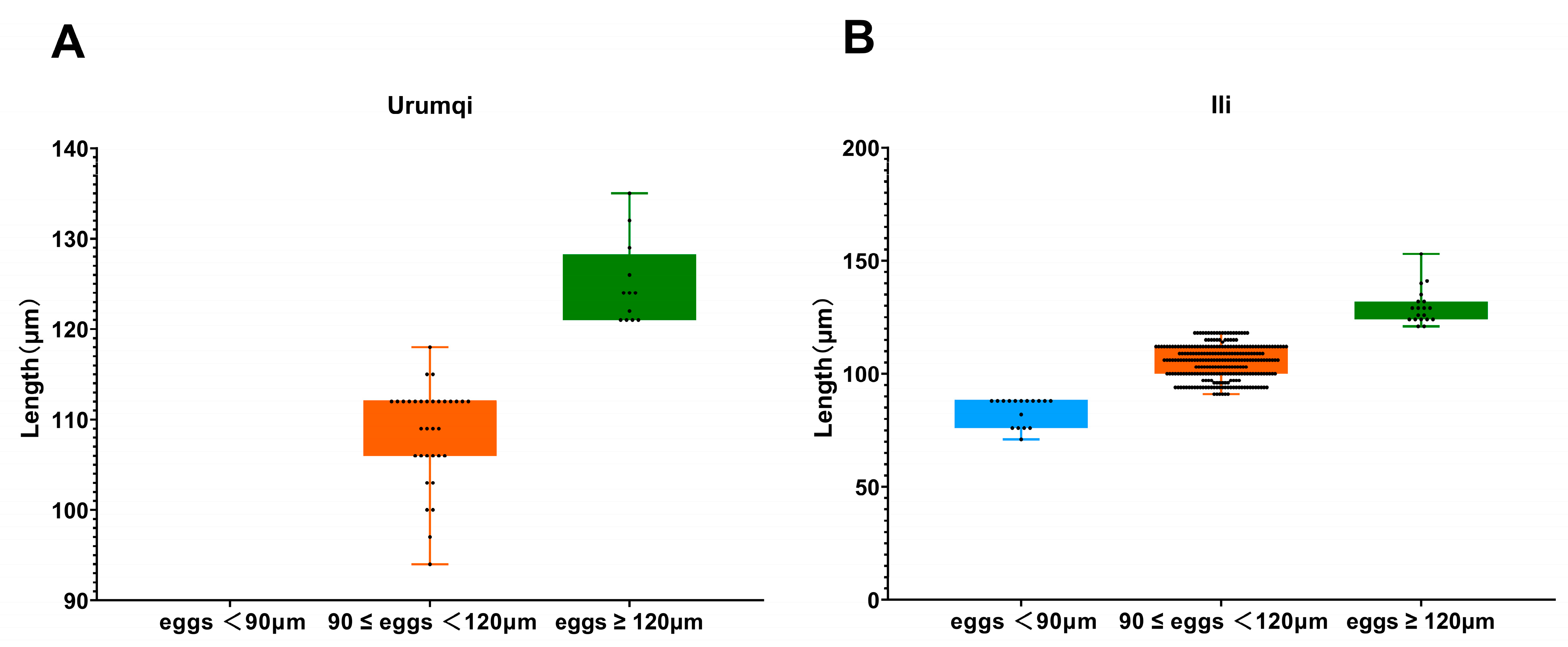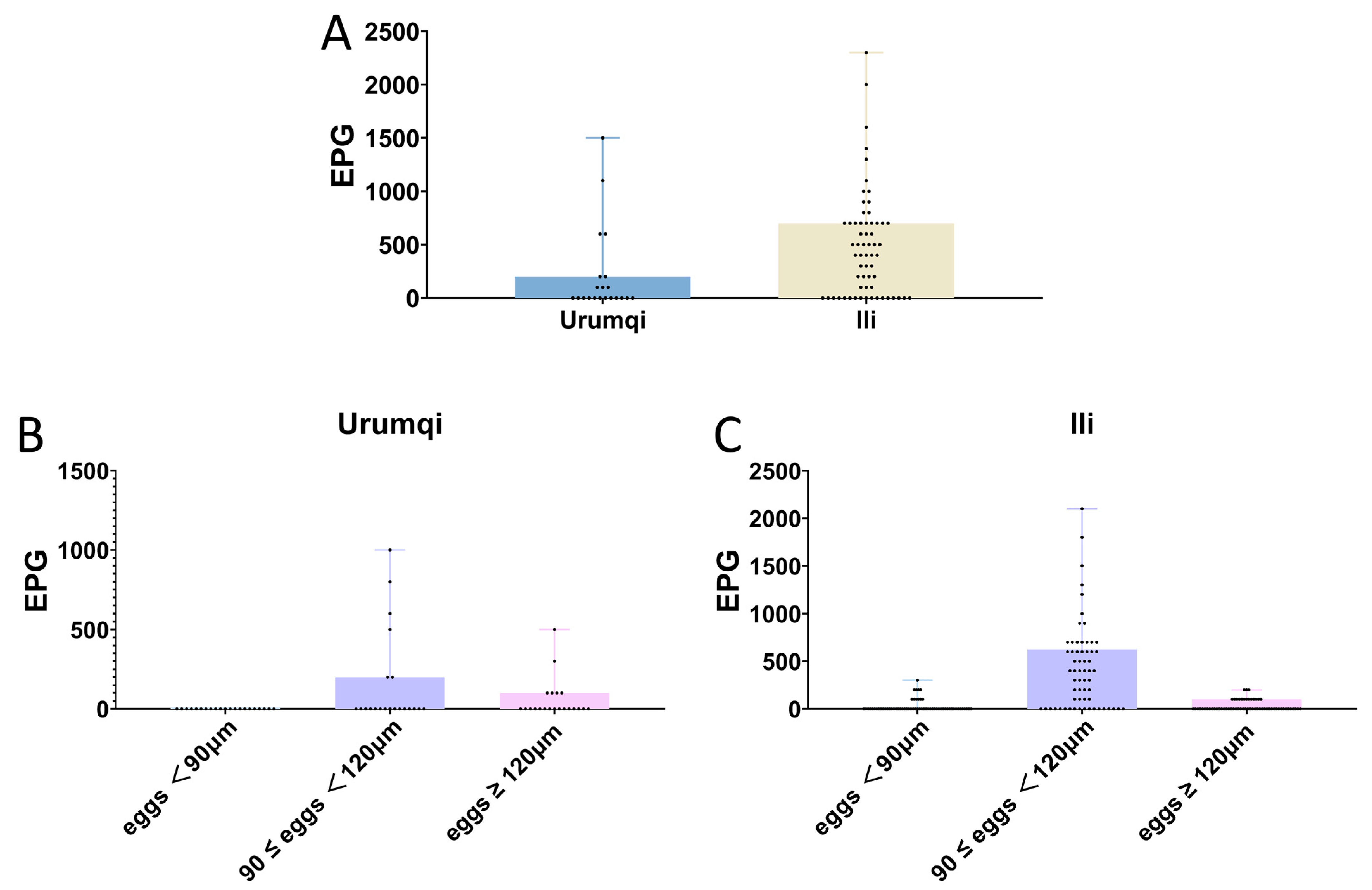Epidemiological Patterns of Gastrointestinal Parasitic Infections in Equine Populations from Urumqi and Ili, Xinjiang, China
Simple Summary
Abstract
1. Introduction
2. Materials and Methods
2.1. Sample Collection
2.2. Fecal Egg Counts
2.3. Statistical Analyses
3. Results
3.1. Descriptive Data Analysis
3.2. Infection Intensity of Different Parasite Species
4. Discussion
5. Conclusions
Supplementary Materials
Author Contributions
Funding
Institutional Review Board Statement
Informed Consent Statement
Data Availability Statement
Conflicts of Interest
References
- Cai, H.; Ma, Q.; Gao, M.; Hu, Y. Earliest direct evidence of horse husbandry and essential social network for sacrificial rituals during the Western Zhou Dynasty in China. Quat. Sci. Rev. 2024, 344, 108997. [Google Scholar] [CrossRef]
- Penghui, L.; Zhongying, Z.; Xiaohai, T.; Chen, M.; Xiaoyu, X.; Yuqi, L.; Ge, L.; Mayikardan, D. Current Situation of Xinjiang Horse Breeding Industry and Suggestions for Development Countermeasures. Chin. Livest. Poult. Breed. 2025, 6, 10–15. [Google Scholar]
- Villa-Mancera, A.; Aldeco-Pérez, M.; Molina-Mendoza, P.; Hernández-Guzmán, K.; Figueroa-Castillo, J.A.; Reynoso-Palomar, A. Prevalence and risk factors of gastrointestinal nematode infestation of horses, donkeys and mules in tropical, dry and temperate regions in Mexico. Parasitol. Int. 2021, 81, 102265. [Google Scholar] [CrossRef]
- Mathewos, M.; Teshome, D.; Fesseha, H. Study on Gastrointestinal Nematodes of Equines in and around Bekoji, South Eastern Ethiopia. J. Parasitol. Res. 2022, 2022, 8210160. [Google Scholar] [CrossRef]
- Harvey, A.M.; Meggiolaro, M.N.; Hall, E.; Watts, E.T.; Ramp, D.; Šlapeta, J. Wild horse populations in south-east Australia have a high prevalence of Strongylus vulgaris and may act as a reservoir of infection for domestic horses. Int. J. Parasitol. Parasites Wildl. 2019, 8, 156–163. [Google Scholar] [CrossRef]
- de Freitas, M.G.; Dos Santos, G.H.; Silva, D.L.Z.; Costa, T.D.; Borges, D.G.L.; Reckziegel, G.H.; Cleveland, H.; do Nascimento Ramos, C.A.; Pereira, F.B.; de Almeida Borges, F. Strategic control of gastrointestinal nematodes in equines in an extensive livestock production system in a tropical region. Vet. Parasitol. 2025, 335, 110425. [Google Scholar] [CrossRef] [PubMed]
- Halvarsson, P.; Grandi, G.; Hägglund, S.; Höglund, J. Gastrointestinal parasite community structure in horses after the introduction of selective anthelmintic treatment strategies. Vet. Parasitol. 2024, 326, 110111. [Google Scholar] [CrossRef]
- Lichtenfels, J.R.; Kharchenko, V.A.; Dvojnos, G.M. Illustrated identification keys to strongylid parasites (Strongylidae: Nematoda) of horses, zebras and asses (Equidae). Vet. Parasitol. 2008, 156, 4–161. [Google Scholar] [CrossRef]
- Ogbourne, C. Pathogenesis of Cyathostome (Trichonema) Infections of the Horse. A Review; Commonwealth Agricultural Bureaux: Slough, UK, 1978. [Google Scholar]
- Reinemeyer, C.; Smith, S.; Gabel, A.; Herd, R. The prevalence and intensity of internal parasites of horses in the USA. Vet. Parasitol. 1984, 15, 75–83. [Google Scholar] [CrossRef]
- Reinemeyer, C.R.; Nielsen, M.K. Parasitism and colic. Vet. Clin. Equine Pract. 2009, 25, 233–245. [Google Scholar] [CrossRef]
- Duncan, J.; Pirie, H. The pathogenesis of single experimental infections with Strongylus vulgaris in foals. Res. Vet. Sci. 1975, 18, 82–93. [Google Scholar] [CrossRef]
- Zhou, M.; Lu, Y.; Han, L.; Lu, M.; Guan, C.; Yu, J.; Liu, H.; Chen, D.; Li, H.; Yang, Y.; et al. Exploration of Parascaris species in three different Equus populations in China. Parasit. Vectors 2023, 16, 202. [Google Scholar] [CrossRef] [PubMed]
- Rendle, D.; Hughes, K.; Bowen, M.; Bull, K.; Cameron, I.; Furtado, T.; Peachey, L.; Sharpe, L.; Hodgkinson, J. BEVA primary care clinical guidelines: Equine parasite control. Equine Vet. J. 2024, 56, 392–423. [Google Scholar] [CrossRef]
- Poissant, J.; Gavriliuc, S.; Bellaw, J.; Redman, E.M.; Avramenko, R.W.; Robinson, D.; Workentine, M.L.; Shury, T.K.; Jenkins, E.J.; McLoughlin, P.D.; et al. A repeatable and quantitative DNA metabarcoding assay to characterize mixed strongyle infections in horses. Int. J. Parasitol. 2021, 51, 183–192. [Google Scholar] [CrossRef] [PubMed]
- Bracken, M.K.; Wøhlk, C.B.M.; Petersen, S.L.; Nielsen, M.K. Evaluation of conventional PCR for detection of Strongylus vulgaris on horse farms. Vet. Parasitol. 2012, 184, 387–391. [Google Scholar] [CrossRef]
- Nielsen, M.; Olsen, S.; Lyons, E.; Monrad, J.; Thamsborg, S. Real-time PCR evaluation of Strongylus vulgaris in horses on farms in Denmark and Central Kentucky. Vet. Parasitol. 2012, 190, 461–466. [Google Scholar] [CrossRef]
- Cristescu, M.E. From barcoding single individuals to metabarcoding biological communities: Towards an integrative approach to the study of global biodiversity. Trends Ecol. Evol. 2014, 29, 566–571. [Google Scholar] [CrossRef]
- Ley, R.E.; Lozupone, C.A.; Hamady, M.; Knight, R.; Gordon, J.I. Worlds within worlds: Evolution of the vertebrate gut microbiota. Nat. Rev. Microbiol. 2008, 6, 776–788. [Google Scholar] [CrossRef] [PubMed]
- Ruppert, K.M.; Kline, R.J.; Rahman, M.S. Past, present, and future perspectives of environmental DNA (eDNA) metabarcoding: A systematic review in methods, monitoring, and applications of global eDNA. Glob. Ecol. Conserv. 2019, 17, e00547. [Google Scholar] [CrossRef]
- Nielsen, M.K. What makes a good fecal egg count technique? Vet. Parasitol. 2021, 296, 109509. [Google Scholar] [CrossRef]
- Paras, K.L.; George, M.M.; Vidyashankar, A.N.; Kaplan, R.M. Comparison of fecal egg counting methods in four livestock species. Vet. Parasitol. 2018, 257, 21–27. [Google Scholar] [CrossRef] [PubMed]
- Nielsen, M. Parasite faecal egg counts in equine veterinary practice. Equine Vet. Educ. 2022, 34, 584–591. [Google Scholar] [CrossRef]
- Li, Y.; Deng, H.; Suoyili; Li, J.; Bayeer, B. Analysis of Gastrointestinal Parasite Infections in Horses in the Ili River Valley. Anim. Husb. Vet. Med. 2015, 92–94. (In Chinese) [Google Scholar]
- Wang, M. The Dynamic Investigation of Digestive Tract Parasitic of Horse and the Clinicle Experiment of Insecticid in Xin Jiang Zhaosu. Master’s Thesis, Xinjiang Agricultural University, Urumqi, China, 2015. [Google Scholar]
- Saes, I.d.L.; Gonçalves, J.A.; Do Carmo, T.A.; Mena, M.O.; Cipriano, I.d.A.; Favare, G.M.d.; Bello, H.J.S.; Guelpa, G.J.; de Soutello, R.V.G. Seasonality and dynamics of gastrointestinal helminths in grazing horses. Acta Vet. 2022, 72, 131. [Google Scholar] [CrossRef]
- Reinemeyer, C.R. Current concerns about control programs in temperate climates. Vet. Parasitol. 1999, 85, 163–172. [Google Scholar] [CrossRef]
- Beasley, A.; Abbas, G.; Hughes, K.; El-Hage, C.; Jacobson, C.; Bauquier, J.; Wilkes, E.; Carrigan, P.; Cudmore, L.; Hurley, J.; et al. Australian guidelines for equine internal parasite management. Aust. Vet. J. 2025, 103, 151–158. [Google Scholar] [CrossRef]
- Bowman, D.D.; Georgi, J.R. Georgis’ Parasitology for Veterinarians; W.B. Saunders Company: Philadelphia, PA, USA, 2013. [Google Scholar]
- Otranto, D.; Wall, R. Veterinary Parasitology; John Wiley & Sons: Hoboken, NJ, USA, 2024. [Google Scholar]
- Mulaw Berihun, A.; Bizu, F.; Maru, M.; Kassaw, S. Prevalence, Associated Risk Factors, and Identification of the Genera of Equine Strongyles in Horses and Donkeys in and Around Bishoftu, Ethiopia. Vet. Med. Int. 2024, 2024, 3224113. [Google Scholar] [CrossRef]
- Abbas, G.; Ghafar, A.; Bauquier, J.; Beasley, A.; Ling, E.; Gauci, C.G.; El-Hage, C.; Wilkes, E.J.A.; McConnell, E.; Carrigan, P.; et al. Prevalence and diversity of ascarid and strongylid nematodes in Australian Thoroughbred horses using next-generation sequencing and bioinformatic tools. Vet. Parasitol. 2023, 323, 110048. [Google Scholar] [CrossRef]
- Phetkarl, T.; Fungwithaya, P.; Lewchalermvong, K.; Sontigun, N. Prevalence of gastrointestinal and blood parasites in horses of Nakhon Si Thammarat province, Thailand. Vet. World 2024, 17, 2460–2468. [Google Scholar] [CrossRef]
- Kuzmina, T.A.; Lyons, E.T.; Tolliver, S.C.; Dzeverin, I.I.; Kharchenko, V.A. Fecundity of various species of strongylids (Nematoda: Strongylidae)--parasites of domestic horses. Parasitol. Res. 2012, 111, 2265–2271. [Google Scholar] [CrossRef]
- Hedberg Alm, Y.; Tydén, E.; Martin, F.; Lernå, J.; Halvarsson, P. Farm size and biosecurity measures associated with Strongylus vulgaris infection in horses. Equine Vet. J. 2025, 57, 703–711. [Google Scholar] [CrossRef]
- Soutello, R.V.G.; Romão, D.S.; do Carmo, T.A.; de Favare, G.M.; Pagnozzi, F.C.; de Almeida Cipriano, I. Seasonal dynamics of gastrointestinal helminths in naturally infected horses in Brazil. Vet. Parasitol. 2025, 333, 110358. [Google Scholar] [CrossRef] [PubMed]
- Kalibinuer, E. The Epidemiological Research and the Identification of Common Parasite Donkey in Southern of Xinjiang. Master’s Thesis, Xinjiang Agricultural University, Urumqi, China, 2015. [Google Scholar]
- Carminatti, A.; Chitolina, M.B.; Ribeiro, A.B.; Forest, M.; Collet, S.G.; Prestes, A.M.; Camillo, G. Occurrence and risk factors associated with gastrointestinal parasitism in horses reared in different systems. Vet. Parasitol. Reg. Stud. Rep. 2023, 42, 100890. [Google Scholar] [CrossRef] [PubMed]
- Ryu, S.H.; An, S.J.; Forbes, E.; Kim, B.S.; Choe, S. Comparison of prevalence and strongyle egg counts per gram of feces in horses at pasture and in stables following ivermectin/praziquantel treatment. Parasitol. Int. 2025, 108, 103072. [Google Scholar] [CrossRef] [PubMed]
- Hamad, M.H.; Jitsamai, W.; Chinkangsadarn, T.; Ngangam, T.S.; Wattanapornpilom, T.; Naraporn, D.; Ouisuwan, S.; Taweethavonsawat, P. Prevalence, risk factors, and species diversity of strongylid nematodes in domesticated Thai horses: Insights from ITS-2 rDNA metabarcoding. Parasitol. Res. 2024, 123, 410. [Google Scholar] [CrossRef]
- LI, B.; Zunujiang, K.; Li, J.; Feng, Y.; Ran, D.; Li, Q.; Guo, Q.; Li, Y. Epidemiological Investigation on Alimentary Tract Parasites of Donkeys under House Feeding in Some Areas of Southern Xinjiang. Chin. J. Vet. Med. 2023, 59, 28–35. [Google Scholar]
- Gorji, F.F.; Sadr, S.; Borji, H. Epidemiological study on equine coccidiosis in North and Northeast of Iran. Vet. Med. Sci. 2023, 9, 2038–2041. [Google Scholar] [CrossRef]




| Variable | Positive | Total | Prevalence (%) | 95% Confidence Interval | p-Value | |
|---|---|---|---|---|---|---|
| Region | Urumqi | 9 | 21 | 42.9 | 22.6–65.6 | <0.01 |
| Ili | 46 | 62 | 74.2 | 61.3–84.1 | ||
| Breed | Kazak horse | 9 | 21 | 42.9 | 22.6–65.6 | <0.001 |
| Yili horse | 32 | 34 | 94.1 | 79.0–99.0 | ||
| Management system | Stable | 14 | 28 | 50.0 | 31.1–68.9 | <0.001 |
| Pasture | 32 | 34 | 94.1 | 79.0–99.0 | ||
| Total | 55 | 83 | 66.3 | 55.0–76.1 |
| Site | Positive Value of Total Strongyles (EPG) | Positive Value of Strongyles of Eggs < 90 μm (EPG) | Positive Value of 90 μm ≤ Strongyles of Eggs < 120 μm (EPG) | Positive Value of Triodontophorus spp. (EPG) | Positive Value of P. equorum (EPG) | Positive Value of Eimeria (OPG) |
|---|---|---|---|---|---|---|
| Urumqi | 9 (100–1500) | 0 | 6 (200–1000) | 6 (100–500) | 0 | 0 |
| Ili | 45 (100–2300) | 11 (100–300) | 44 (100–2100) | 16 (100–200) | 2 (100–900) | 3 (100) |
| Total | 54 (100–2300) | 11 (100–300) | 50 (100–2100) | 22 (100–500) | 2 (100–900) | 3 (100) |
Disclaimer/Publisher’s Note: The statements, opinions and data contained in all publications are solely those of the individual author(s) and contributor(s) and not of MDPI and/or the editor(s). MDPI and/or the editor(s) disclaim responsibility for any injury to people or property resulting from any ideas, methods, instructions or products referred to in the content. |
© 2025 by the authors. Licensee MDPI, Basel, Switzerland. This article is an open access article distributed under the terms and conditions of the Creative Commons Attribution (CC BY) license (https://creativecommons.org/licenses/by/4.0/).
Share and Cite
Lu, Y.; Ru, P.; Qin, S.; Zhang, Y.; Fu, E.; Cai, M.; Tuohuti, N.; Wu, H.; Zhang, Y.; Zhang, Y. Epidemiological Patterns of Gastrointestinal Parasitic Infections in Equine Populations from Urumqi and Ili, Xinjiang, China. Vet. Sci. 2025, 12, 644. https://doi.org/10.3390/vetsci12070644
Lu Y, Ru P, Qin S, Zhang Y, Fu E, Cai M, Tuohuti N, Wu H, Zhang Y, Zhang Y. Epidemiological Patterns of Gastrointestinal Parasitic Infections in Equine Populations from Urumqi and Ili, Xinjiang, China. Veterinary Sciences. 2025; 12(7):644. https://doi.org/10.3390/vetsci12070644
Chicago/Turabian StyleLu, Yabin, Penghui Ru, Sinan Qin, Yukun Zhang, Enning Fu, Mingyue Cai, Nuermaimaiti Tuohuti, Hui Wu, Yi Zhang, and Yang Zhang. 2025. "Epidemiological Patterns of Gastrointestinal Parasitic Infections in Equine Populations from Urumqi and Ili, Xinjiang, China" Veterinary Sciences 12, no. 7: 644. https://doi.org/10.3390/vetsci12070644
APA StyleLu, Y., Ru, P., Qin, S., Zhang, Y., Fu, E., Cai, M., Tuohuti, N., Wu, H., Zhang, Y., & Zhang, Y. (2025). Epidemiological Patterns of Gastrointestinal Parasitic Infections in Equine Populations from Urumqi and Ili, Xinjiang, China. Veterinary Sciences, 12(7), 644. https://doi.org/10.3390/vetsci12070644






